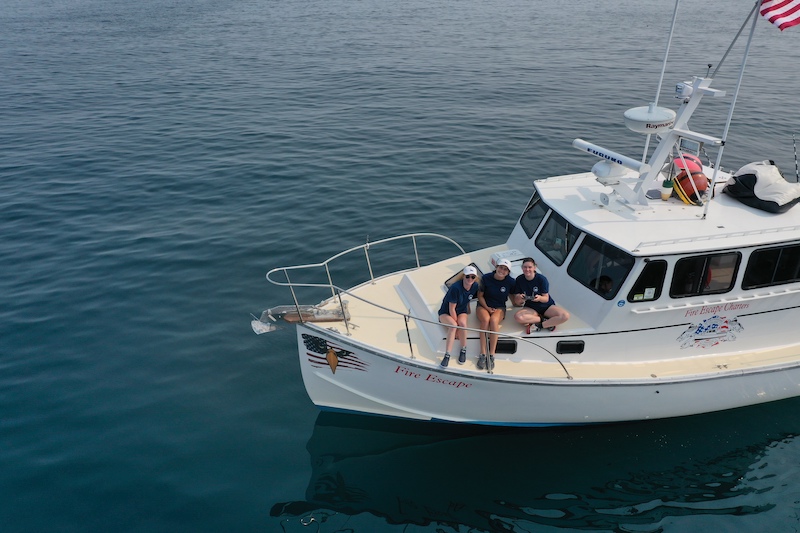
Our second week of fieldwork was full of excitement. With the field days planned for Thursday and Friday, our week began in preparation mode: practice drone launches, BRUV deployments, and packing Pelican cases. A series of equipment failures provided a learning experience for our interns as we delved into manuals and YouTube videos, stepping into the life of a marine biologist and becoming experts on the fly. In the lab, our team is getting ready to process samples (waiting in our -80°C freezer) from Beneath the Waves’ research around the world, including the Turks and Caicos, Bahamas, Cape Cod, and the UK. Despite the technological malfeasances in the lab, our team was eager to get into the water and find some sharks!
Preparing the gear
Each tagging day is a calculated operation. We begin the trip with an early morning drive to Plymouth Harbor, where we rendezvous with the captain. Loading the Pelican cases, fishing equipment, and other supplies only takes a few minutes. Heading out to the deeper waters of Stellwagen Bank, we cast a few fishing lines to catch a few mackerel to chum the water. Soon after that, we take our DNA samples using a Niskin bottle which we drop at 30ft and 100ft depths. Niskin bottles are plastic cylinders with stoppers at each end in order to seal the bottle completely. They are used to take water samples at the desired depth without mixing with water from other depths. These bottles can be processed in the lab the following day using our pump. Eventually, we will send the sample to a lab where scientists will analyze them to show the biodiversity of marine life in the area.

Interns on board. Credit: Beneath The Waves.
Deployment
Next, Seba and Kate set up the BRUV (Baited Remote Underwater Video) with a bait arm and GoPro, dropping it to 300ft to sit and record for the day. An acoustic receiver and hydrophone communicate with the BRUV to float to the surface at the end of the day so we could retrieve it. Later in the lab, the interns watched the GoPro footage, witnessing hours of open ocean, admiring the vastness of the ecosystem. They were unable to find anything, however, the experience of looking at 300 feet of deep ocean was a treat. Finding ‘Nothing’ is still data! In the future, we hope to see sharks and other species’ behaviors on the BRUV footage.
The boat continues to drive 20+ miles offshore. The crew begins setting up the deep sea fishing poles, baited with either bluefish or mackerel. Each pole sits at a different depth in the water to cover more ground. The back of the boat holds buckets of chum. Chum creates an oily slick in the ship’s wake, which the sharks can follow to the boat.
Blue shark encounter
Just 20 minutes after settling in to wait for a bite, a blue shark casually made its way towards the ship. It nudged the chum bucket and curiously swam around the boat before we dropped a hook in front of it. Once the crew hooked the blue shark, Brendan, Christine, and Seba held it against the ship. Then the boat is put in a low gear, so oxygenated water could flow through the shark’s gills. Kate started by taking morphology, a small fin clip from the dorsal, and then made an incision next to the dorsal to take a small muscle sample. Researchers inserted a spaghetti tag below its fin with an ID number and phone number. If caught in the future, the crew could collect additional information about the blue shark.
Lastly, the team took a cloacal swab and blood sample before attaching an extra pop-up tag to track the shark via satellite. This 7ft blue was the perfect first shark because of how calm he was, making the Thursday group’s first workup just 8 minutes. To ensure the shark is under low stress, Beneath the Waves aims to keep the workups quick.
The samples and data collected will be used to study the shark’s diet, stress, and hormone levels. A shark’s diet, stress, and hormone levels are analyzed to determine its overall health. Researchers use results to expand knowledge of sharks. Beneath the Waves further presents this information to support protections for these amazing creatures.
Edited by Nathan Perisic.
About the authors
Kate Quigley is an intern for Beneath the Waves at their new lab. She grew up spending her weekends and summers exploring the Chesapeake Bay, where her passion for the ocean began. While kayaking, swimming, and canoeing on the bay, she became exceptionally curious about marine species and the immense amount of biodiversity underwater. During her first open water scuba dive, she encountered two sevengill sharks and has been fascinated with these creatures ever since. When met with the chance to work with sharks at Beneath the Waves, she jumped at the opportunity. She is currently a rising senior at Winston Churchill High School in Potomac, Maryland where she leads the school’s climate club and has implemented a school-wide composting program. In college, she intends to study environmental science and marine biology in hopes of building a sustainable blue economy and solutions for improving ocean conservation efforts.
Jacob Cotter is an intern for Beneath the Waves in their new lab. Growing up in suburban Massachusetts, JC spent his childhood summers in the waters off Cape Cod where his love for ocean life began. As someone who is fascinated by the work being done to inspire change in our oceans, he jumped at the opportunity to take part in meaningful research with such a great NGO. Currently, JC is a rising senior at Thayer Academy where he leads the school’s Sustainability Club and advocates for a greener and more sustainable campus. In college, JC plans to study environmental engineering with hopes of promoting a cleaner world.










